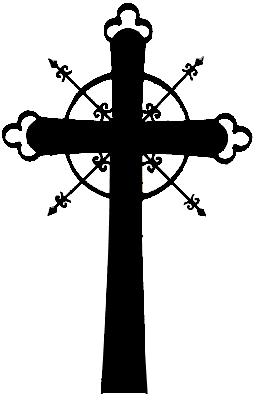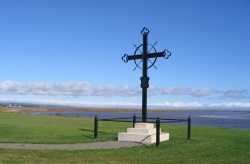Acadian Cross

Each Atlantic province in Canada has at least one monument to the Acadian heritage. The monuments mark the period around 1755 known as Grand Dérangement, Deportation, or the Upheaval, where the people of Acadie were expelled from Nova Scotia, New Brunswick and Prince Edward Island.
The original Deportation Cross, dedicated in 1929 near the Grand-Pré National Historic Site in Nova Scotia, marks the site of embarkation of over 2,000 Acadian farmers, tradesmen, artisans and their families.
The latest monument to be erected was in 2013 in Port au Port Peninsula, Newfoundland and Labrador, after Prince Edward Island received its monument in 2008. New Brunswick has four and there's one in St. Pierre and Miquelon. Other crosses have been, or will be, erected at landing points in Quebec, France, UK, USA, and Caribbean.
A plaque attached to each monument tells the story of the local connection of the Upheaval.
After a long and slow journey, many Acadian exiles settled in Louisiana between 1794 – 1809. Their French name les Cadiens is more familiarly called Cajun and their ethnicity has made a prominent impact on the state's culture, not only with the Cajun French language but also food and music.
Cross description
The Acadian residents were exiled by the British yet ironically, the eight-arm design of the memorial cross has similarities with the union flag of the United Kingdom which also appears on the flags of British Columbia, Manitoba, and Ontario.
Each thin arrow-like arm of the diagonal St Andrew's Cross is, however, embellished with a Fleur de lis at the tips, which gives a distinctly French connection.
The Celtic Circle is also associated with north and west Britain, yet that also has continental European origins.
The main cross limbs (vertical and horizontal) form a Greek Cross. These limbs are budded, meaning new growth and new beginning.
The eight-arm design also appears on several Canadian flags, such as British Columbia, Manitoba, Newfoundland and Labrador, and Ontario. (See the links in the last few sentences for further information.)
A Christian cross such as this, pointing in eight compass directions, is a reminder of Christ's command to go out to the world and preach the Gospel. This cross has an obvious additional meaning, in that the Acadians dispersed in several directions.
Longfellow immortalises the Upheaval through his epic poem Evangeline.


